"Through space the universe encompasses and swallows me up like an atom; through thought I comprehend the world." -Blaise Pascal
Whether you have or haven't seen the xkcd webcomic, height (or my old post referencing it), one of the things that I can't imagine not fascinating you is what you see the farther "up" you look.
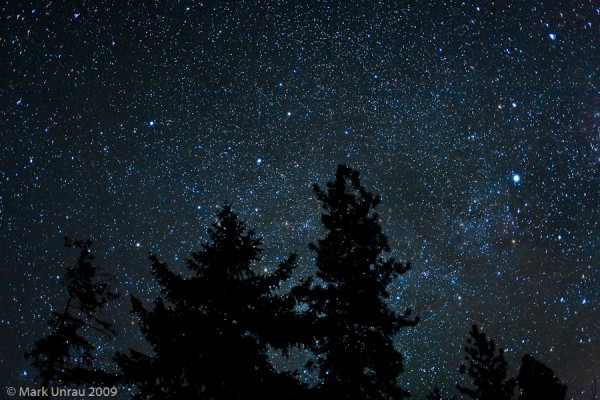
So what I'm going to do is start off in the vicinity of Earth and go "up" by approximately a factor of 100 every time. Let's begin.
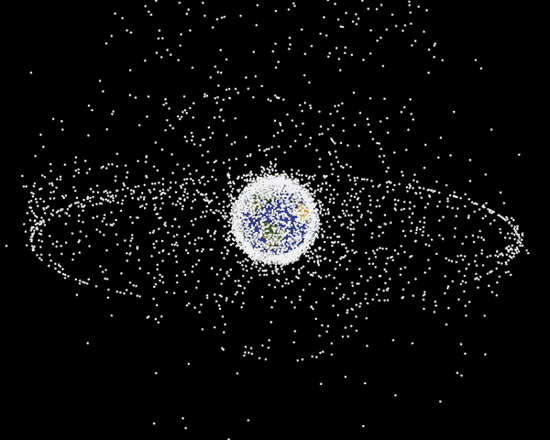
Ahh, outer space. Looking down at the Earth from a distance, what would you see? Well, other than the planet itself, you'd see the (literally) thousands and thousands of satellites that are currently up and orbiting our planet. Most of them are just a few hundred kilometers (or miles) above the surface, but there are a large number of geostationary satellites, that orbit the Earth with the same period as the Earth's rotation, farther out.
But what if we moved 100 times farther away from the center of the Earth, and looked back?
Some of our most sophisticated satellites and telescopes, such as WMAP, Herschel and Planck, are out beyond the orbit of the Moon! Moving 100 times farther away puts us at their location, with the Earth and Moon easily enclosed in that area.
But you want to get a different planet from Earth? Try going up another factor of 100.
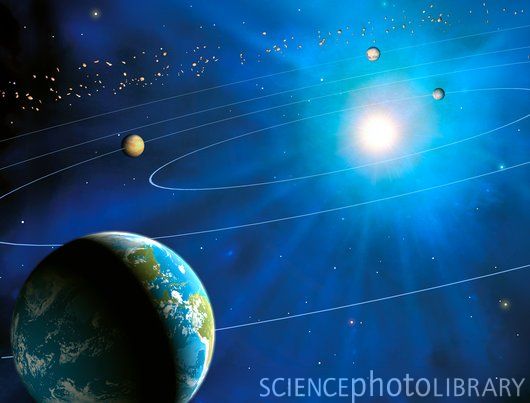
And now, instead of just some satellites and the Moon, you get all of the inner, rocky planets, the Sun, and the asteroid belt!
But out journey is just beginning. Another factor of 100 will take you far.

It will take you, in fact, out to the edge of our Solar System! Getting all the planets, the Kuiper Belt objects, and even the farthest satellites we've ever sent (the Voyagers and Pioneers), another factor of 100 will take you out just past the heliopause, and into interstellar space.
But we haven't gotten to another star, yet. Try going up by another factor of 100!
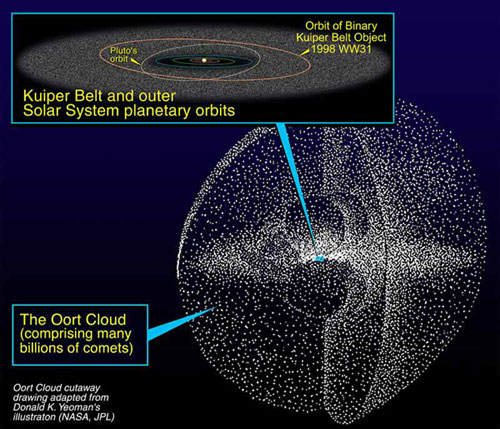
And -- believe it or not -- that won't get you there! Going out 100 times farther than the edge of the Solar System will not even get you to the nearest star! (Not including our Sun, of course.) But it will let you see the entire Oort cloud, where (we believe) there are billions of frozen objects, just waiting to pass close enough to a star to melt a little, grow a tail and become a comet.
It's time for another factor of 100, and what do we get?

At last, the closest stars to our Sun are in full view! Alpha Centauri is typically what we think of as the closest star to us, at 4.3 light-years distant, but it's actually a system of three stars!
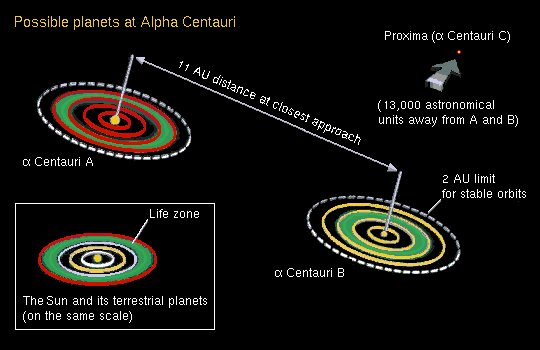
The two binary stars, Alpha Centauri A and B, are both somewhat Sun-like, and may have planets (with or without life) orbiting them, but the third small, distant member of the system, known as Proxima Centauri, is actually the closest star to us, at just 4.24 light-years!
So now, we've got a few stars within sight. What happens if we go up by another factor of 100?

That's what I'm talking about! Most of the bright stars in our night sky, such as Sirius, Capella, Vega, and Arcturus, are now all within view. The closest open star cluster to us -- the Hyades -- as shown below, is here, too.

So now we've got thousands and thousands of stars, including an open star cluster, and you think you're ready for your next step?
Okay, another factor of 100, coming up!

We get the whole galaxy! Spiral arms, the bar in the center, over 100 globular clusters, gas, dust, new stars, old stars, dying stars, future stars... all of it! Pictured above, of course, is not our galaxy, but NGC 6744, what we think of as our galaxy's "twin".
It's a beautiful sight, to be sure. And you might be wondering, after what we just went through with our Solar System and the next nearest star, if the next step of "100" will get you to the next nearest galaxy or not.
Ready to find out?
Unbelievably, galaxies are much harder to escape from on these scales! We not only get the entirety of our local group, including M31 (Andromeda), the Triangulum Galaxy, and the Magellanic Clouds, among others, but we also get other groups of galaxies, including the spectacular M81 group, shown below.

So you might be wondering if the next step up will take you to the spectacular galaxy clusters we find in our Universe. Let's find out! Another factor of 100 gets us...
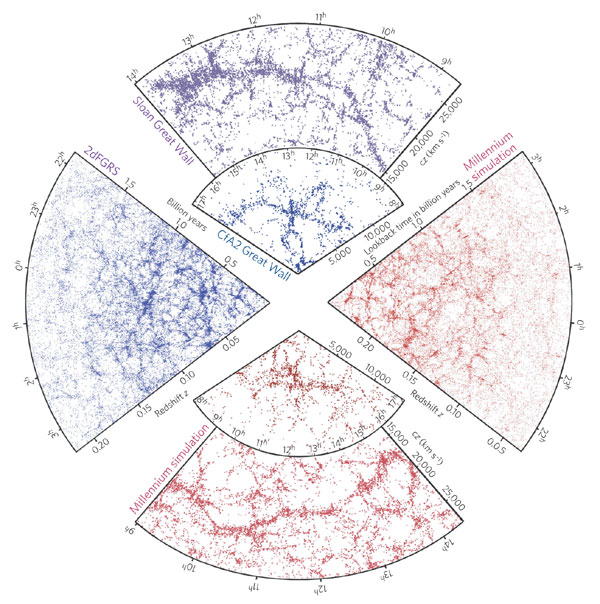
A spider web? Oh, no. You see, in the image above -- courtesy of the 2 degree Field galaxy redshift survey -- each pixel in that image is an entire galaxy.
What you're seeing is how galaxies cluster on the largest scales in the Universe. And the answer, unsurprisingly, is in great clumps and filaments. The densest clumps -- like the Coma Cluster (below) -- make up grand galaxy clusters.

Image Credit: NASA, JPL-Caltech, SDSS, Leigh Jenkins, Ann Hornschemeier (Goddard Space Flight Center) et al.
But those grand filaments? The collections of galaxies in great lines across space? Those are even larger features. The largest ever discovered, in fact. The greatest one -- in size -- that we've ever seen? The Sloan Great Wall, about a billion light-years across, below.
This thing is so big that it isn't even gravitationally bound to itself all the way across! That's right! Over time, this object will fragment into many smaller clusters, as dark energy and the expansion of the Universe will tear this "great wall" apart.
And so -- one last time -- we go up by as close to a factor of 100 as we can. (A factor of about 47, in fact.)
And we come to a baby picture of the Universe, when it was only 380,000 years old. 46.5 billion light years away, this nearly-uniform light is the leftover glow from the big bang. Slightly "hot" spots indicate an underdensity of matter by less than 0.01% from the average, while "cold" spots indicate an overdensity by the same amount.
The hottest spots will eventually shrink into great voids, where galaxies and structure are very sparse and rare, while the coldest spots will gravitationally attract more and more matter, and will grow into galaxies, clusters, and -- for a brief time -- great walls.
And while I'd love to show you the updated Powers of 10 video, there are copyright issues I have no control over.
But I have something even better. No, not the xkcd height comic, even better than that. Courtesy of Gott et al., 2005, ApJ, 624, 463, comes the true scientist's version of a Logarithmic map of the Universe, from the surface of the Earth all the way up to the farthest reaches of the known Universe.

A full, 300 dpi printable version is available here. I hope you enjoyed this phenomenal tour of the different distance scales in the Universe, and thanks for "going up" with me!



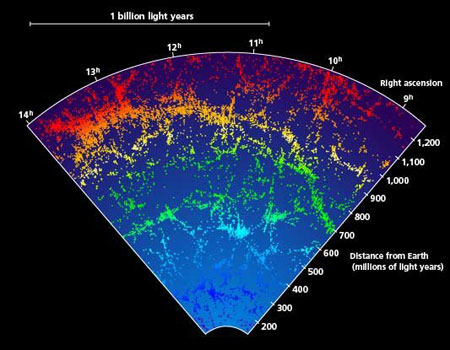

Fascinating, and thank you for the tour.
Your mention of the Bar at the Centre of the Galaxy reminded me of the Restaurant at the End of the Universe!
One question from an ignorant layman -- you mention the baby picture of the universe is 46.5 billion light years away.
Is that possible? - I thought the universe was only about 14 billion years old.
zackoz,
This is one of the most bizarre things about distances in cosmology, but your understanding is correct! I have written a few posts on this topic over the years. Here was one from January: http://scienceblogs.com/startswithabang/2011/01/q_a_how_is_the_universe…
Many places get it wrong, include the award-winning application referenced in this post: http://scienceblogs.com/startswithabang/2010/10/the_scale_and_limits_of…
And back in 2009, I had my first in-depth attempt to answer it: http://scienceblogs.com/startswithabang/2009/07/the_size_of_the_univers…
Hope these links help!
I am so using this post with my students. Awesome [in the best sense of the word]. Thanks for this terrific blog!
Thanks Ethan. If nothing else this tutorial should teach us how unbelievably puny and helpless we are on Earth and why we need to preserve it, instead of sending it into a dumpster via rail car, which we are doing now by lousing up its atmosphere, among other things. Science is supposed to teach. And science tells us, as this explication makes clear, that absent a total refutation of special relativity, that there is no 'safe harbor' for hue-munns (as the Ferengi would say) within accessible reach ... well ... forever ... outside of Earth itself. Terraform Mars all you want, build within it a livable atmosphere, but that is about as much as we can expect in the 100-500 year time horizon. Unless, of course, Einstein and all of observable physics is totally wrong. Let's hope!
You say "on the largest scales in the Universe", and I can't help but to think of my small cichlids in my first small fish tank. They were building a wall, but were they really? So I got them a bigger tank, and they we building two walls. Eventually I got them a massive tank, and of course they were digging a hole to live in. But from their first limit of their and my visible universe, that structure was not visible.
And even though we can't see more than the visible part of universe, where there are filaments and clumps on the largest scales in the Universe - does that mean it is the largest structure? I'm sure there's some answer on the lines of - any other part of the universe not visible from here can also not interact with this part of the universe and therefore the filaments and clumps are the largest structures. But would it really have the same structure, if we instead were looking from that earth-like planet on the edge of our visible universe?
@Ethan: I'd suggest you link to one of those old articles every time when you mention the 46.5 billion light years; this question inevitably comes up again every time...
It appears that the early universe would be the very largest thing we can detect/see, it being that which surrounds us in all directions (not just "up")at nearly 50 billion light years away, and yet this most massive image represents the "beginning" of all things which has nevertheless been termed a singularity by some. One would logically think the universe would get smaller looking into the past and larger over the passage of time as the thing expands. Are we "looking into the past" or not? I think the term we can use here is that this is "nonintuitive".
The two binary stars, Alpha Centauri A and B, are both somewhat Sun-like, and may have planets (with or without life) orbiting them, but the third small, distant member of the system, known as Proxima Centauri, is actually the closest star to us, at just 4.24 light-years!
It is my understanding that it is unlikely that multiple star systems can have planetary systems that are stable over time because such star systems produce large non-central forces that will inevitably cause the orbits to decay.
Nice. Here is an awesome diagram of distance scales from XKCD
http://xkcd.com/482/
I understand the use of "up" in reference to the xkcd height comic, and when orienting with the Logarithmic map of the Universe, but I think "up" and "down" reinforces flatland thinking. In the same way that when referencing a mercator projection, people tend to use "up" to the North Pole and "down" to the South Pole, "up" and "down" is a false artifact of our frame of reference.
"Up" and "down" have little meaning once we pierce the thin shell of our atmosphere and slip the bonds of Earth's gravitational influence.
Ethan, I was happy to see you briefly slip out of this convention:
I find it much more meaningful to reference "in" and "out" of a gravity well.
I think that just about takes care of my interweb pedantry for today. ;)
Very nice post and pictures, i really enjoy reading your blog (and your photos on facebook)!
I'm always amused to see newspaper advertisements for binoculars that promise you that they ar so powerfull that they allow you to see 60 km, without indicating what it is that you're supposed to be able to see. I always think that without the binoculars I can see at night millions of light years, even if I just confine myself to the Andromeda Galaxy.
Right near the top of your last diagram you have the Sloan Great Wall at z = .1, which is only about a billion light years away.
Then at the top you have the CMB where z = 3200 or so.
Now there isn't much observation data between z = .1 and z = 3200. For example the most distant star or galaxy ever observed is at z = 10.
Now my question is this. Does the anisotropy in the WMAP image align with the Sloan Great Wall? Meaning, from the WMAP data, can the location of the Sloan Great Wall be determined?
Also, since the Sloan Great Wall is 1 Billion lightyears long; does that mean that our universe is isotropic on much larger scales than the grain size (1 billion light years) of the Sloan Great Wall? It would seem to me that the universe must be anisotropic at scales less than the Sloan Great Wall where there are great clumps of matter such as galaxies, superclusters of galaxies.
Any clarification of the standard theory on this matter would be appreciated. Thanks.
Ethan,
Multi-tasking again; an ear to PBS Newshour while reading your blog. But just barely as US politics began to seem increasingly -- er, small? Your blog is a treat, and where you go, I will happily follow!
wow, I really enjoyed that. What a trip! Cheers for putting it on-line
The original (AFAIK) "Powers of Ten" is available here:
http://www.youtube.com/watch?v=0fKBhvDjuy0